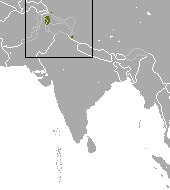Cashmere pygmy shrew
| Cashmere pygmy shrew | ||||||||||||
|---|---|---|---|---|---|---|---|---|---|---|---|---|
| Systematics | ||||||||||||
|
||||||||||||
| Scientific name | ||||||||||||
| Sorex planiceps | ||||||||||||
| Miller , 1911 |
The cashmere pygmy shrew ( Sorex planiceps ) is a species of shrew from the genus of the red- toothed shrews ( Sorex ). It occurs in South Asia in the Kashmir region on the border between India and Pakistan and in the far west of the People's Republic of China in the provinces of Xinjiang and Xizang .
features
With a head-trunk length of 5.7 to 7.3 centimeters, the cashmere pygmy shrew is one of the medium-sized shrew species. The tail reaches a length of 37 to 48 millimeters - and is thus shorter than the rest of the body - the rear foot is 10 to 14 millimeters. The fur on the back is brown, towards the belly the color gradually changes to brown-gray. The feet are light and the tail is dark brown on top and light gray to white on the underside.
| 1 | · | 5 | · | 1 | · | 3 | = 32 |
| 1 | · | 1 | · | 1 | · | 3 |
As most species of the genus has the type in the maxilla per half an incisor (incisor) and then five unicuspid teeth, a Vorbackenzahn (premolar) and three molars (molar). In the lower jaw, however, it has a single canine behind the incisor. Overall, the animals have a set of 32 teeth. The tooth roots are colored red as in most red-toothed shrews. The second single-pointed tooth of the upper jaw is smaller than the first and third. From the very similar pygmy shrew ( S. minutus ) and the Tibetan shrew ( S. thibetanus ), the Kashmir pygmy shrew differs in its slightly larger shape and slightly flatter brain skull.
distribution
The Kashmir pygmy shrew occurs in South Asia in the Kashmir region on the border between India and Pakistan and in the extreme west of the People's Republic of China in the provinces of Xinjiang and Xizang . The altitude distribution is between 2280 and 3970 meters.
Way of life
The Kashmiri pygmy shrew lives in coniferous forest and montane rock regions at heights of up to almost 4,000 meters on soils that are covered with snow for up to eight months. Like all shrews, this species feeds on invertebrates, especially woodlice and insects.
Systematics
The cashmere pygmy shrew is classified as an independent species within the genus of the red- toothed shrew ( Sorex ), which consists of around 80 species. The first scientific description comes from Gerrit Smith Miller from 1911, who described an individual from the Indian part of Kashmir. The species was partially assigned to the Tibetan shrew ( S. thibetanus ) as a subspecies and the relationship to the Bukhara shrew ( S. buchariensis ) in the Pamirs is also unclear.
Apart from the nominate form Sorex planiceps planiceps, no further subspecies are distinguished within the species .
Threat and protection
The Kashmir pygmy shrew, although it is rarely seen, from the International Union for Conservation of Nature and Natural Resources not endangered as (IUCN) due to the overall relatively large and undisturbed distribution areas, the assumed large inventory and nonexistent inventory threat (least concern ) classified.
literature
- Robert S. Hoffmann, Darrin Lunde: Kasmir Shrew. In: Andrew T. Smith , Yan Xie: A Guide to the Mammals of China. Princeton University Press, Princeton NJ 2008, ISBN 978-0-691-09984-2 , p. 314.
Web links
- Sorex planiceps inthe IUCN 2013 Red List of Threatened Species . Posted by: S. Molur, PO Nameer, 2008. Retrieved January 2, 2014.
supporting documents
- ↑ a b c d e Robert S. Hoffmann, Darrin Lunde: Kasmir Shrew. In: Andrew T. Smith , Yan Xie: A Guide to the Mammals of China. Princeton University Press, Princeton NJ 2008, ISBN 978-0-691-09984-2 , p. 314.
- ↑ a b c Sorex planiceps in the IUCN Red List of Threatened Species 2013.2. Posted by: S. Molur, PO Nameer, 2008. Retrieved January 2, 2014.
- ↑ a b c d Sorex planiceps ( Memento of the original from January 2, 2014 in the Internet Archive ) Info: The archive link was inserted automatically and has not yet been checked. Please check the original and archive link according to the instructions and then remove this notice. . In: Don E. Wilson , DeeAnn M. Reeder (Eds.): Mammal Species of the World. A taxonomic and geographic Reference. 2 volumes. 3. Edition. Johns Hopkins University Press, Baltimore MD 2005, ISBN 0-8018-8221-4 .
